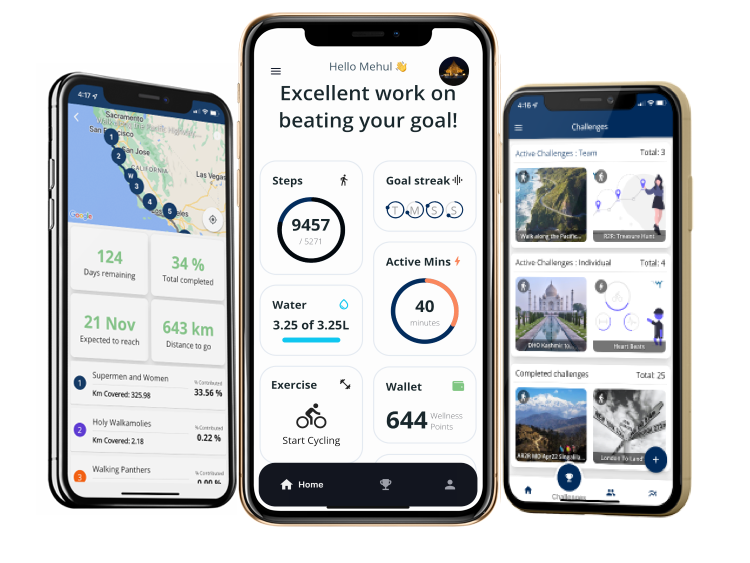The answer to any question worth asking is usually “it depends” 🤷♂️ because only super straightforward questions can be answered with a definitive yes or no! 😬
In this article, we’ll break down the title question into two separate ones: 1) How to make workplace step challenges “work”? and 2) Under what circumstances do step challenges don’t work?
Let’s begin with laying the foundation.

What’s a corporate step challenge?
A step challenge is an activity or competition that tracks the number of steps a person or a team takes and ranks them on a leaderboard.
A corporate step challenge helps create friendly competition amongst employees, engaging them and creating a buzz within the business while also promoting a culture that prioritises employee health & wellbeing.
While there’s a clear benefit to employee health by participating in a corporate step challenge, often times an additional incentive is needed, either a charitable contribution for their steps walked or gift cards / discounts and other corporate benefits as reward.
How do you know if a corporate step challenge “works”?
There are two key drivers to assessing if a corporate step challenge worked:
- How many employees engaged?
- Is the employee impact long tailed?
For businesses with less than 150-200 employees, target to engage at least 50% of employees. For larger businesses, actively engaging more than 25-30% of employee base is success.
The other important, but harder, success criteria is whether the impact on employees is long tailed. What we mean by that is whether employees continue to see benefits of a step challenge, be it continuing to walk more regularly, feel more connected with the business and/or collaborate more across departments, long after the step challenge has ended. At W2Y, we do this with a short anonymous employee survey at the end of the challenge and share aggregated results with the HR Leaders.
Key drivers of a successful workplace step challenge?
- Leaders leading by example and walking the talk: This is one of the biggest contributors to getting employees to engage with a workplace initiative. Leaders influence culture and when Execs are involved, they demonstrate a culture that prioritises health, wellbeing and bonding. Often times, it’s left to the HR teams to drum up excitement & adoption, but that’s not always enough for continued employee engagement and boost to team culture if leadership is not engaged!
- Ease of employee onboarding: Make it easy for your employees to get onboarded & participate in a team activity. This includes meeting them where they are – if your employee base consists of mobile & in office workers, having a desktop driven team activity will not find adoption with mobile employees. From our perspective, gold standard is where any employee, located anywhere in the world can participate in a team activity with just a smartphone and can sign up in less than 2 mins.
- If the challenge is fun and engaging, it’ll encourage employees to participate. Try a symbolic virtual race, for example, connecting different offices on a virtual map or covering the iconic Route 66 in the US – this works out much better than a simple step leaderboard. Additionally, plan to continuously communicate milestones & updates with the whole business. It can draw in employees who are on the sidelines to participate and energise the ones who have already signed up. Don’t just start and depart 😉
- Finally, we come to rewards. There’s plethora of behavioural science research (and we have written a blog on it) that reinforce the value of gamification & incentives in driving employees to engage and build long term habits. Rewards can be at a company level, aligned with values and mission, for example donating to charity for every step walked, or they can be personal, for example, redeeming wellness points for free coffee vouchers, company/partner merchandise, etc. Be creative, your employees will reward you with high engagement 😊
Circumstances that lead to a step challenge not working?
This is easy to answer as we have already outlined the key drivers for success. In essence, if employees find it hard to sign up or don’t have the requisite motivation (aka personal or team rewards), it’s analogous to trying to lift off a hot air balloon with a puncture. It may take off, but altitude is limited and engagement will drop off dramatically.
Similarly, if the logistical elements mentioned above appear addressed, but leadership is not engaged, employee adoption and a boost to workplace culture will suffer. Why? Because leaders influence culture, through action and inaction. It has a trickle down effect on middle managers championing individual wellbeing & prioritising team bonding.
Finally, lean on over-communicating during a step challenge and not under-communicating. Launching is only half job done. Be sure to talk about the challenge in company wide meetings, 1:1s, in Lunch n’ learns, etc. Share updates & milestones achieved – internally and even on social media. Some of the most successful customers we have partnered with are really creative in this – some have even reported wellbeing metrics (steps, leading teams, milestones, etc) in company wide & Board dashboards. Wow! 🤩
How can Walk With You (W2Y) help you run engaging, impactful and most importantly fun step challenges for your business?

We have tremendous experience in running exciting step challenges and engaging employees globally. For businesses with less than 200 employees, our step challenges have seen 75%+ employees actively engaged, creating buzz & excitement through the entire organisation.
We do this by supporting & advising our customers on all the key drivers of success, be it making it super easy for employees to sign up and join a team challenge, or regularly post on internal Community Board to keep the engagement and motivation high.
If you are looking to turbocharge your employee engagement & wellbeing and believe we can help – do get in touch!


No responses yet